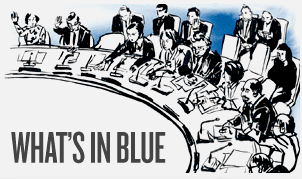Arria-Formula Meeting on Small Arms and Light Weapons
Tomorrow (16 September), Security Council members will convene for a virtual Arria-formula meeting on “The threat to international peace and security posed by the illicit trade in small arms and light weapons”. The meeting is being organised by Mexico. The expected briefers are Ivor Richard Fung, Deputy Chief of the Conventional Arms Branch at the UN Office for Disarmament Affairs (UNODA); Paul Holtom, Conventional Arms Programme Lead at the UN Institute for Disarmament Research (UNIDIR); Simonetta Grassi, Head of the Global Firearms Programme at the UN Office on Drugs and Crime (UNODC); Rachel Stohl, Vice President of Research Programs and Director of the Conventional Defense Program at the Stimson Center; and Wanda Muñoz, Expert of the Human Security Network in Latin America and the Caribbean. The meeting is open to participation from the wider membership of the UN and will be broadcast on UNTV at 10 am EST. Mexico plans to prepare a chair’s summary of the meeting reflecting the remarks and interventions of the briefers and the participants.
Mexico has circulated a concept note for the meeting, which says that the widespread availability, misuse and illicit trade of small arms and light weapons (SALW) endanger peace and security, enables human rights violations and hinders humanitarian access and development. It notes that the Security Council has been discussing issues relating to SALW in its deliberations on country-specific situations and on thematic issues such as Security Sector Reform (SSR) and underscores the need for the Council to continue addressing the challenge and threats posed by the illicit trafficking of SALW in a consistent manner.
According to the concept note, tomorrow’s meeting aims to facilitate discussion on current and emerging challenges regarding the illicit trade of SALW and on ways to promote the necessary synergies across the UN system to address this issue. The meeting will also provide an opportunity for members to reflect on how the Security Council can be more effective in addressing this issue and strengthen its preventive role. The concept note stresses the need to build on the momentum generated by the successful outcome of the seventh Biennial Meeting of States (BMS7) on the UN Programme of Action to Prevent, Combat, and Eradicate the Illicit Trade in Small Arms and Light Weapons (UNPoA) and the seventh Conference of States Parties (CSP7) of the Arms Trade Treaty (ATT) that were held from 26 to 30 July and from 30 August to 3 September, respectively.
The concept note suggests the following guiding questions for discussion:
- Has the Security Council adequately addressed the threat to peace and security posed by the trafficking in and illicit trade of SALW and their ammunition?
- How can the Security Council ensure, through arms embargoes or other similar tools, that SALW and their ammunition are not diverted to or traded with unauthorised recipients?
- Have different treaties, programs under regional organisations, Sustainable Development Goal 16.4 (to significantly reduce illicit financial and arms flows, strengthen the recovery and return of stolen assets and combat all forms of organised crime), and initiatives from civil society been incorporated in the Council’s approach to SALW?
- What concrete and practical steps can be taken to “break the silos” and complement approaches to avoid a fragmented approach on this issue?
The Security Council has been considering the challenges and threats posed by the spread of SALW to international peace and security as an agenda item since 1999. In September 2013, the Council adopted resolution 2117, the first resolution on SALW, which focused on their illicit transfer, destabilising accumulation and misuse. This was followed by the adoption of resolution 2220 of 22 May 2015, which called for the bolstering of international cooperation and effective implementation of UN arms embargoes and for increased support to the ATT. Resolution 2220 requested the Secretary-General to continue submitting biennial reports to the Security Council on this issue, which have been informing Council discussions on SALW. These biennial reports were first requested through a presidential statement (S/PRST/2007/24) in June 2007. The Council also adopted resolution 2457 of 27 February 2019 on “Silencing the Guns in Africa”, endorsing the African Union’s flagship initiative to end violent conflict in the continent. The resolution emphasised the importance of tackling illicit arms to achieve a conflict-free Africa and underscored the need for effective implementation of relevant arms control instruments and regimes, in particular those related to small arms and light weapons.
As six years have passed since the adoption of resolution 2220, it seems that Mexico’s intention in organising tomorrow’s Arria-formula meeting is to draw Council members’ attention to the growing threats posed by SALW to international peace and security. High Representative for Disarmament Affairs Izumi Nakamitsu noted in her latest briefing to the Council on the Secretary-General’s sixth biennial report on SALW, which took place on 5 February 2020, that “[w]ith an estimated one billion small arms in circulation worldwide, the use of these weapons in lethal violence, whether in conflict or non-conflict settings, is prevalent across regions and subregions from the Americas to Africa to Southern Europe”, adding that “[n]o State is immune from the challenges posed by illicit arms flows”.
The issue of preventing and combating the illicit trade in SALW is one of Mexico’s key priorities during its Security Council tenure. As it prepares to assume the Council’s rotating presidency in November, Mexico apparently wants to build momentum on this issue over the coming months. It seems that Mexico aims to facilitate discussion on how the Council can use its various tools in strengthening measures to control arms transfers and prevent their diversion to unauthorised end-users. In October, during Kenya’s Presidency, the Council is expected to hold a briefing on SALW based on the Secretary-General’s seventh biennial report. The report is expected to be released later this month.

